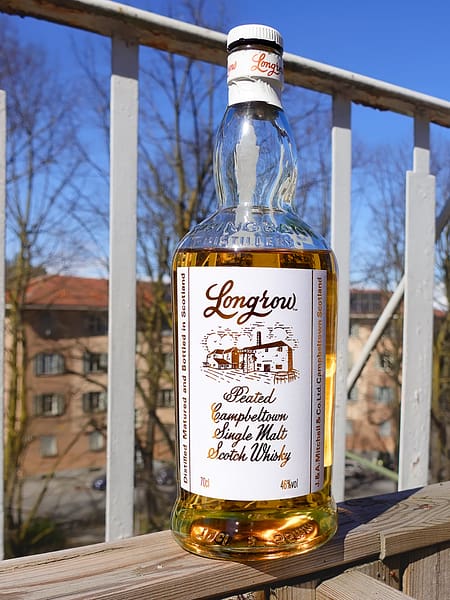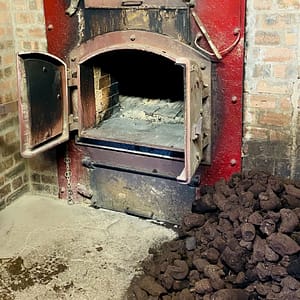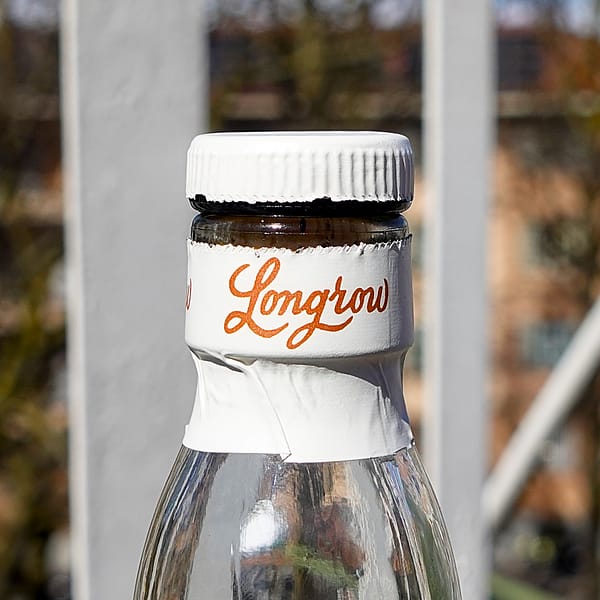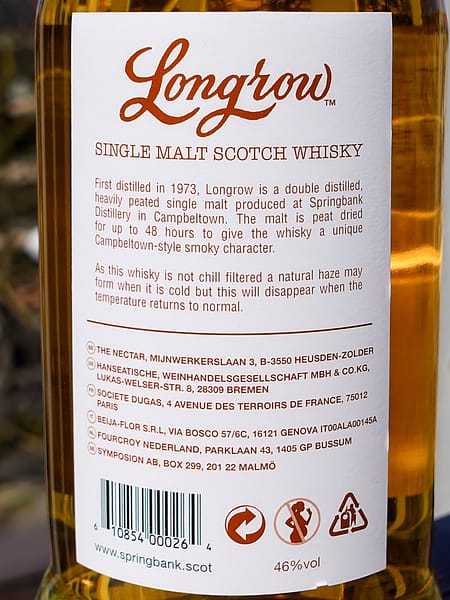As I approach the end of my entry-level peat whisky exploration, it is time to move away from Islay. Today I am in Campbeltown with the review of the Springbank’s non age statement Longrow Peated single malt. With all the hype around Springbank, I couldn’t miss the chance to grab a bottle when the opportunity presented itself. It was also high time to try a whisky made outside of Islay with a different peat source (besides the Port Charlotte 10 ) and see what the difference in nose and taste would be.

TL:DR: Simple, young, a bit rustic, but full of character. A fun dram.
Vote*: 6, good stuff
Put three whisky geeks in a room and the chance that discussion will at some point land on Springbank during the evening is one you shouldn’t bet against. When talking about Scottish distilleries and the most hyped, most wanted ones, Springbank is at the top of the list. And it isn’t even a close race. Just have a look at Dramface’s 40 top distilleries list. The vote differential between Springbank and the 2 & 3 spot to realise how whisky aficionados feel. If you are still relatively new to whisky, the paragraphs below summarise Springbank’s hype and reputation today. For most of you this is old news. Feel free to skip to the short history of Longrow or to today’s review of the entry-level Longrow peated.
THE Scottish whisky unicorn: Springbank
There are three factors I would highlight, If you are looking for why Springbank is such a hyped distillery. The conjunction of limited production (below 1 million litres pa.), traditional in-house barley-to-bottle production and a reputation for great whisky hit a perfect trifecta for whisky fans. Online, there are pages and pages, hours of videos buying into the hype. Occasionally, some go against the grain. If you want to dive deeper a quick Google search will open a proverbial Pandora’s box of information.
What is interesting to me is that more often than not the contrarians argue about the value, not the quality. When talking about value for Springbank a distinction is needed between Springbank’s RRP, which is fair and hard to criticise, vs the secondary market prices set, by flippers or by shops, to exploit the hype for profit. Unfortunately, unless you are at the source or lucky enough to grab a new release from an honest shop, Springbank’s rarity means that secondary prices are often the only ones available to many.
There is some hope though. Recently I have seen more Springbank 10 year old and even the 15 at close to RRP in several online shops. These don’t last long but are worth keeping an eye out for. The two exceptions to this rule seem to be Springbank’s Campbeltown Loch blended malt and the subject of today’s whisky review, the Longrow Peated NAS, which in some cases is even available on offer below RRP. So f you are keen to try a Springbank product this bottle might be the best chance out there.
Longrow: from lost distillery to brand
Today Longrow is a brand used for Springbank’s peated line. Back in the XIX century, it used to be one of over 30 distilleries in Campbeltown, active from 1824 to 1896. Its location was very close to Springbank and its former site now hosts the bottling line for Springbank itself. In case you are interested in learnign more about Campbeltown’s lost distilleries, there are many online sources: this one from the Whisky Aardvark offers a good overview.

Springbank revived the Longrow range in 1973 intending to offer peated whiskies in the tradition of the peated Campbeltown whiskies popular in the Victorian era. Longrow makes up only about 10% of Springbank’s limited output using peated malt produced directly at the distillery, using two types of peat, a dry one, which you can see in the pic to the side next to the malting kiln furnace, and a wet one, both from mainland Scotland.
The current Longrow Peated is a more recent whisky. From what I could find digging online, its first edition was released in 2012, replacing the earlier Longrow CV produced between 2008 and 2012. Considering I called Caol Ila 12 a whisky that cosplays as an old timer bottle, it would be justified to call Longrow out for the same behaviour. After all, this bottle looks as old-fashioned, with a no fucks given label that makes you wonder if someone picked it straight from a 50’s grocery shop. Except that this is Springbank after all. The minimal effort approach to labels and marketing is the house style, so the look and feel of the Longrow Peated I am about to review is 100% aligned with that ethos rather than dressing.
Longrow Peated



Specs
Price paid: €59.75
Bottled date: 1/7/2022
ABV: 46%
Natural colour: Not stated on the bottle, so is it?
Non-chill filtered: Yes
Casks Used: Bourbon and Sherry
Tasting Notes
Colour: Golden ripe wheat. We all assume this is natural colour but sorry Springbank, the rules are the same for everyone. If you don’t put it on the label, there is no guarantee for the consumer. Other bottles I have (Springbank 10 and 15) do state “natural colour. This makes me wonder if there is indeed a touch of caramel here. Blasphemy to some, I am sure.
Nose: Coming from the previous Islay peated whisky reviews, it is immediately clear that we left the island. The peat isn’t even as evident as I expected, it is very well integrated and only comes forward as a secondary note. First, there is some lovely whisky funk. The start is all ester-rich fruit and dirty workshop notes. There is ripe red apple, melon, pineapple even a hint of berries, vanilla, then a petroly solvent smell, like an old-fashioned wood varnish.
Then the smoke wades in. Unlike the medicinal Islay peat, it is vegetal and floral, with a definite touch of heather. Then slowly more complexity with malted biscuits, golden syrup, some ginger, cumin, a touch of apple cider vinegar and a hint of lanolin.
Taste: The first reaction is that this is quite an oily mouthcoating whisky. It is also more noticeably youthful, with some spicy heat. Malted barley is the taste I get immediately, then a lot of woody peat and sweetness (candied pineapple). Some ginger and a hint of salt emerge. Simpler than the nose but not in a way that leaves me wanting
Finish: The finish is medium-long. Similarly to what I noted for the palate, it is quite straightforward and a bit young. It remains consistent. The malt notes are more evident, then vegetal floral peat, vanilla, and a touch of fruity sweetness. The aftertaste is malty, a little drying.
Vote*: 7 Very good stuff. 6, Good stuff. (I dropped the score of the Longrow Peated after my peated whiskies blinfd tasting, where it really showed its youth compared to the other drams in the flight). It is a bit dirty and rough around the edges, and the youth does come accross on the palate. The pretty straightforward taste profile is characterful and engaging, which beats refined but boring on any day of the week.
* Votes are based on the scoring scale used by Dramface, slightly modified to allow half-points
Closing thoughts
There is always a risk of being disappointed when approaching any product that is hyped. And with Springbank’s reputation, I could have tasted this Longrow peated review expecting some nectar of the gods. I am always sceptical of hype. More than anything I have a contrarian streak which I know would colour my opinion. So to be fair to this Longrow I need to look at it for what it is, an entry-level peated single malt. A single malt with some peculiarities. Its Campbeltown origin and the barley-to-bottle philosophy justify a moderate price premium compared to some of its peers, but not a different judging scale..
Is it a perfect whisky like the hype might suggest? Not at all. Some youth is not completely tamed and overall it is what, in wine terms, would be called rustic. But in that context of an entry-level whisky, it more than holds its own. It’s full of character, exuberant and a bit dirty. That hits many of the things I like in whisky (and not only in whisky).
The way the peat is used is captivating. It is noticeably different form Islay peat, more floral, vegetal and woody. The way it is integrated int he whisky, not as the main overbearing note but as one player in the flavour orchestra, is one of the things I like most about this whisky.
I do have a gripe with the label. Contrary to what happens on Springbank 10 where the lack of added colouring is mentioned, here it is not, as you can see from the back label pic. Since my bottle does not carry the “mit farbstoff” advisory it is indeed caramel colouring-free. But why not state it clearly? If this wasn’t Springbank some whisky geeks would be grumbling.
Would I buy it again?
Very likely, if I can find it close to RRP. That would be £48 or €56 in early 2024. I love the slightly dirty character even with a touch of exuberant youthful character. Plus, the drinking experience is fun and unique. I would not pay over the odds at inflated prices just because someone is speculating on the Springbank’s reputation. Luckily that seems less and less necessary for this whisky.
As with all Springbank’s products, the experience varies from batch to batch. Comparing my notes to others I suspect this is somewhat dirtier and more Bourbon cask driven than other batches. Having 3-4 different batches to try side by side would be a fun tasting to run in the future.
Would I offer this to a new whisky drinker?
As much as I like this whisky, I would not offer Longrow to a complete newbie. When it comes to drinkers a few months into their journey, it depends on the taste of the person. I suspect that the main resistance could come from the youth and those dirty funky workshop notes. So probably it is neither the first Campbeltown nor the first non-Islay peated whisky I would suggest sampling. On the other hand, it might be a good one to take someone open to experimenting and keen to try different flavour profiles. And, if someone needs to run a comparison of different peat signatures this is one to consider. Tasting Longrow Peated vs Ardbeg 10 or Lagavulin 8 will make those differences pop.
Interested in my take on a specific whisky style? Check the full Journey here and jump to the relevant Chapter.
I always find it interesting, after writing my tasting notes, to look at other opinions. Here are a few other reviews of the Longrow Peated I enjoyed:
If you have enjoyed this content, please share a comment below and consider supporting the cost of this blog via the button below